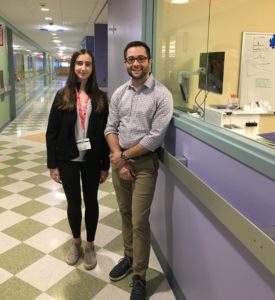Through the generous support of Regeneron, four times a year River Journal publishes the on-site report of a high school science student from the River Towns who is paired with a Regeneron scientist to experience what it is like to put STEM education to work in the real world.
When we think of robots in the workplace, the fear is that they will put humans out of work. From outside the walls of laboratories like Regeneron, it may seem like machines are taking people’s jobs, but the reality is far from a technological apocalypse.
Lab Automation allows researchers to focus more of their time on analyzing data, making new discoveries, and expanding the world’s database of knowledge at a faster rate than ever before.

When I first sat down at Regeneron with automation scientist, Andrew Ortega, he explained to me what exactly he does on a regular basis. Ortega is one of a small population of scientists who program lab machine robots to remove the human element from large-scale experiments.
SCALING UP
Once an experiment has been conducted manually on a small scale, and has proven its potential for further testing, automation scientists like Ortega write programs that will substitute machines for researchers.
Automation protects workers from chemicals that could be harmful
Meanwhile, researchers gain time to move on to bigger and better things, ideas and experiments that they would have had to wait to pursue. Automation is also a more healthy option because it limits exposure to chemicals that could be harmful.
For the mechanical engineering experts behind the busy robots, this means collaboration with specialists from many different fields of science, and constant communication about what is expected from the automation.
BUSY ROBOTS

The robots are capable of doing just about anything; they just need to be told what to do. They can be programmed to carry out multiple experiments at once. The machines, like us, have busy schedules and can perform different functions at different times of the day.
Automation scientists build contingency plans in case there are malfunctions with the program. [Ed. Note: Fans of HBO sci-fi series Westworld are familiar with that possibility.]
Even if data is lost, automation technology can quickly recover, thanks to extreme efficiency. As Ortega continues to work with researchers, he is constantly optimizing his programs to make them as efficient as possible. Automation is constantly improving and revolutionizing science, yet there remains great potential.
Ortega took me to see one of the many labs at Regeneron. We walked past the long glass windows of various labs, some with researchers carrying out manual experiments with a single pipette (a tiny tube used to store and dispense chemicals), and some with massive rotating robot arms.
MACHINES MULTI-TASK
The lab we went into wasn’t bustling with human activity. The robots were the stars of this lab, and the researchers were elsewhere, busy analyzing data. The machines were like giant ovens. Looking inside, instead of baked goods, I found them hard at work pipetting almost 100 things at once. Having used pipettes before, I can only imagine how long it would take me to do what the machines were doing in a matter of seconds.
For people looking to pursue a career in automation, Ortega says the best way for someone to get a foot in the door is, ironically, hands-on automation. He recommends physically working in a lab with automation and exposing yourself to all of its aspects. Because it is still a new field, he says, educational programs may not be the best option.
Overall, my experience at Regeneron was great and has further inspired me to pursue a career in STEM.
Emily Allendorf is a sophomore at Sleepy Hollow High School. She is an active member of her school’s science research program and dances at Logrea Dance Academy.







